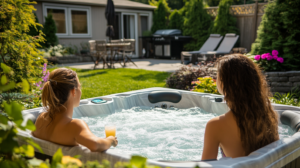Picture this: You’re all set for a relaxing soak in your hot tub, but as you dip your toe in, something feels… off. The water’s cloudy, there’s a funky smell, and your skin starts itching the moment you slide in.
Yep, I’ve been there – and chances are, your hot tub’s alkalinity is the culprit.
Adjusting alkalinity in your hot tub isn’t just about maintaining clear water; it’s the key to creating a safe, comfortable, and enjoyable soaking experience. Get it right, and you’ll be rewarded with silky-smooth water that keeps your equipment happy and your stress levels low.
Ready to become a hot tub chemistry whiz? Let’s dive into the world of alkalinity and discover how to keep your hot tub in perfect balance.
Trust me, your future self (and your pruney fingers) will thank you!
How to Adjust Alkalinity in a Hot Tub
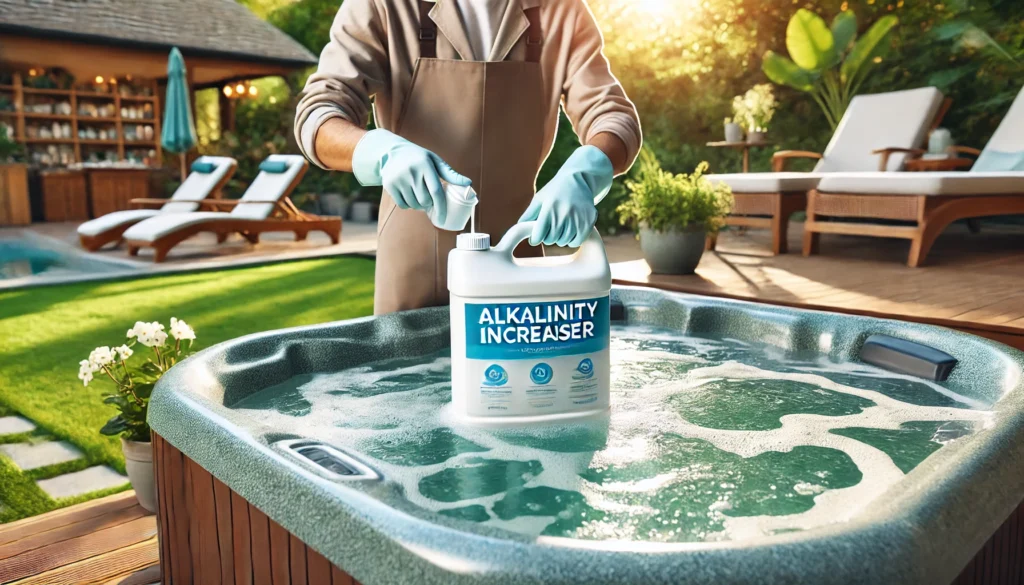
To adjust alkalinity in a hot tub, first test the water using test strips or a liquid test kit. If alkalinity is low, add an alkalinity increaser (sodium bicarbonate) to raise it.
Use about 1 tablespoon per 100 gallons to increase alkalinity by 10 ppm. If alkalinity is high, use a pH decreaser (sodium bisulfate) or the aeration method to lower it.
Always add chemicals with the jets off, wait 15-20 minutes, then run the jets for an hour to circulate. Retest after 24 hours and adjust as needed.
Aim for an alkalinity level between 80-120 ppm, with 100 ppm being ideal for most hot tubs.
Now that we’ve covered the basics of adjusting hot tub alkalinity, let’s dive deeper into the nuances of maintaining perfect water balance.
Understanding the science behind alkalinity and mastering the art of adjusting it will help you create the ultimate hot tub experience.
Understanding Hot Tub Alkalinity

Okay, so what the heck is alkalinity anyway? I remember the first time I heard the term, I was like, “Alka-what-now?”
But here’s the deal: alkalinity is basically your water’s ability to neutralize acids. Think of it as your hot tub’s built-in bouncer, keeping those rowdy pH levels in check.
Now, you’re probably wondering, “What’s the magic number?” Well, for most hot tubs, you want to aim for an alkalinity level between 80 and 120 parts per million (ppm).
But here’s a little secret – I’ve found that keeping it around 100 ppm works like a charm for my tub.
Let me tell you, getting this wrong can be a real pain in the butt. Too high, and you might as well be soaking in a bubble bath (hello, cloudy water and scaling!).
Too low, and your pH will be bouncing around like a kid on a sugar rush, potentially corroding your equipment. Trust me, replacing a heater is NOT a fun weekend project!
The Science Behind Alkalinity
Alright, let’s get a bit nerdy for a second. Total alkalinity is actually a measure of all the alkaline substances dissolved in your water.
These substances, like carbonates, bicarbonates, and hydroxides, act as buffers. They help resist changes in pH, which is crucial for maintaining a stable and comfortable soaking environment.
Think of alkalinity as a shock absorber for your hot tub’s pH. Without enough alkalinity, your pH levels could swing wildly with the slightest change.
And let me tell you, unstable pH can lead to all sorts of issues – from skin irritation to equipment damage.
How to Test Hot Tub Alkalinity
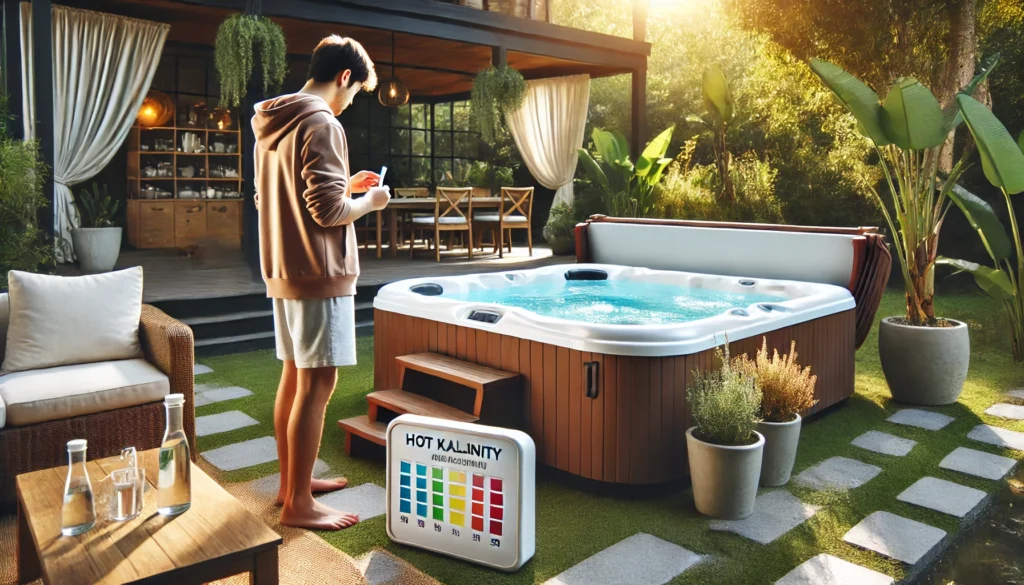
Alright, before we start playing mad scientist, we need to know what we’re dealing with. Testing your hot tub’s alkalinity is crucial, and it’s something I do religiously every week.
You’ve got a couple of options here. Test strips are quick and easy – just dip, compare, and you’re done.
But if you want to feel like a real chemist, go for a titration test kit. It’s a bit more involved, but man, does it make you feel smart!
I remember the first time I used a test strip. I was so nervous, you’d think I was taking an exam!
But it’s seriously easy. Just make sure your hands are dry (learned that the hard way), dip the strip in for a few seconds, and then compare the color to the chart.
Voila! You’ve got your alkalinity reading.
Pro tip: Don’t be like me and test right after adding chemicals or when the jets are running. You’ll get some wonky results, and you’ll be scratching your head wondering what went wrong.
Step-by-Step Testing Process
- Gather your testing supplies. Whether you’re using strips or a liquid kit, make sure you have everything at hand.
- Turn off your hot tub jets and let the water settle for at least 15 minutes.
- If using test strips:
- Dip the strip about 18 inches below the water surface.
- Hold it there for about 15 seconds (don’t swish it around).
- Remove and hold level for 15 more seconds.
- Compare the color to the chart on your test strip bottle.
- If using a liquid test kit:
- Fill the test vial with water from about 18 inches below the surface.
- Add the reagent as directed (usually a drop at a time).
- Count the drops until the color changes.
- Multiply the number of drops by 10 to get your alkalinity in ppm.
- Record your results. Trust me, keeping a log can be super helpful for spotting trends.
Remember, consistency is key. Try to test at the same time of day, under similar conditions, for the most accurate results over time.
Increasing Alkalinity in a Hot Tub
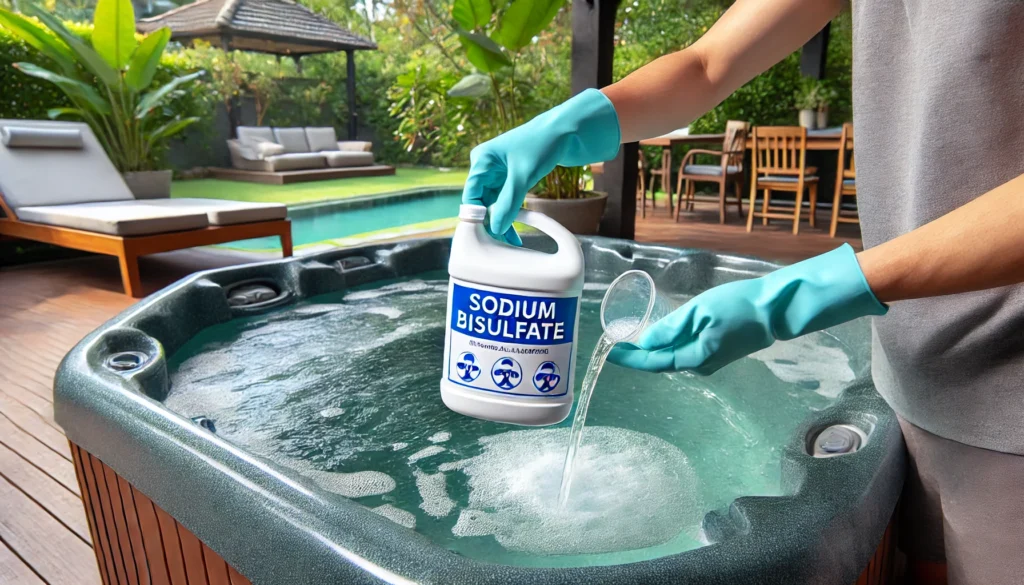
So, your test shows low alkalinity? Don’t panic!
It happens to the best of us. Increasing alkalinity is actually pretty straightforward, and I’ve got a foolproof method that’ll have your hot tub back in balance in no time.
First things first, you’re gonna need some alkalinity increaser. Sodium bicarbonate is your go-to here – yep, that’s just a fancy name for good ol’ baking soda.
I always keep a big box on hand, ’cause you never know when you’ll need it!
Here’s how I do it:
- Figure out how much you need. Generally, about 1 tablespoon per 100 gallons will raise alkalinity by about 10 ppm.
But always check your product instructions!
- Turn off the jets and remove the cover. Trust me, you don’t want chemicals splashing around.
- Sprinkle the alkalinity increaser around the edge of the tub. Don’t just dump it in one spot – spread the love!
- Wait about 15-20 minutes. This is a great time to grab a snack or, you know, stare anxiously at your hot tub.
- Turn the jets on low for about an hour to mix it all up.
- Test again after 24 hours. Patience is key here, folks!
I once tried to rush this process and ended up with alkalinity so high, I thought I was soaking in baking soda! Learn from my mistakes – take it slow and steady.
Why Baking Soda Works
You might be wondering, “Why baking soda?” Well, let me break it down for you.
Baking soda, or sodium bicarbonate, is a base. When you add it to water, it increases the water’s ability to neutralize acids.
This is exactly what we’re looking for when we want to raise alkalinity!
The best part? Baking soda is cheap, safe to handle, and won’t dramatically affect your pH levels.
It’s like the superhero of hot tub chemicals – always there when you need it, without any nasty side effects.
Decreasing Alkalinity in a Hot Tub
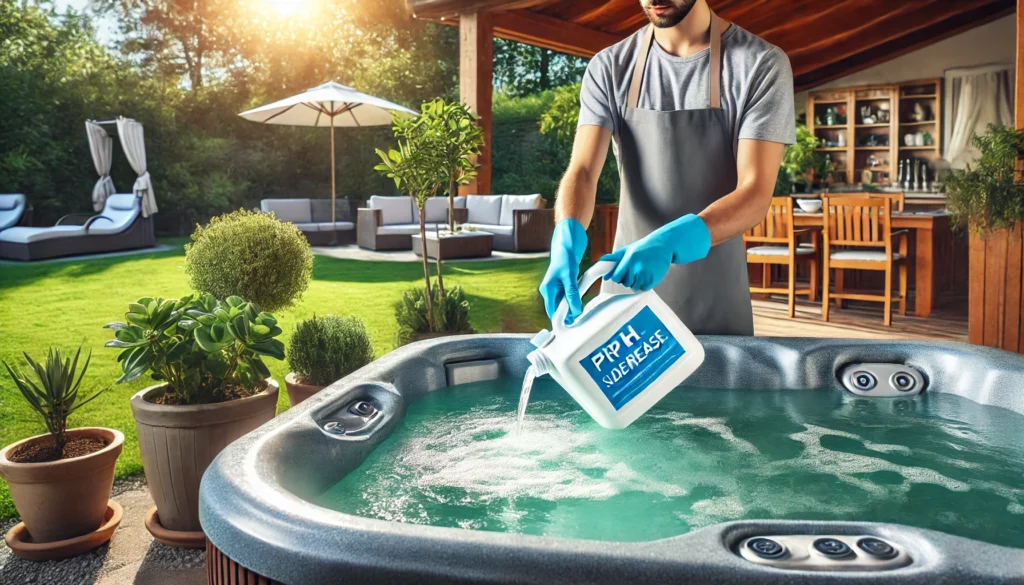
Now, what if your alkalinity is through the roof? Don’t sweat it!
Lowering alkalinity isn’t as common, but it’s totally doable.
You’ve got a couple of options here: muriatic acid or sodium bisulfate (also known as pH decreaser). Personally, I prefer sodium bisulfate.
It’s easier to handle and less likely to make me feel like I’m starring in a mad scientist movie.
Here’s my tried-and-true method:
- Safety first! Put on some gloves and goggles.
Trust me, you don’t want this stuff in your eyes.
- Turn off the jets and remove the cover.
- Dilute the sodium bisulfate in a bucket of water. Never add water to acid – always acid to water!
- Slowly pour the diluted solution around the edge of the tub.
- Wait about 15-20 minutes. Maybe do a little dance to pass the time?
- Turn the jets on low for about an hour to mix it all up.
- Test again after 24 hours. Crossing your fingers is optional but encouraged!
Word of caution: go easy on the decreaser. It’s way easier to add more than to deal with alkalinity that’s dropped too low.
Trust me, I learned this the hard way and spent a whole weekend trying to balance my tub!
The Aeration Method
Here’s a little trick I picked up along the way – the aeration method. If your alkalinity is just a tad high, you might be able to lower it naturally without adding any chemicals.
Here’s how:
- Remove the hot tub cover.
- Turn on all the jets to their highest setting.
- Adjust the air valves to allow maximum air into the water.
- Let it run for several hours or overnight.
The increased aeration causes some of the dissolved carbon dioxide to be released from the water, which can naturally lower alkalinity. It’s not as fast as using chemicals, but it’s gentler on your water and equipment.
Maintaining Proper Alkalinity Levels
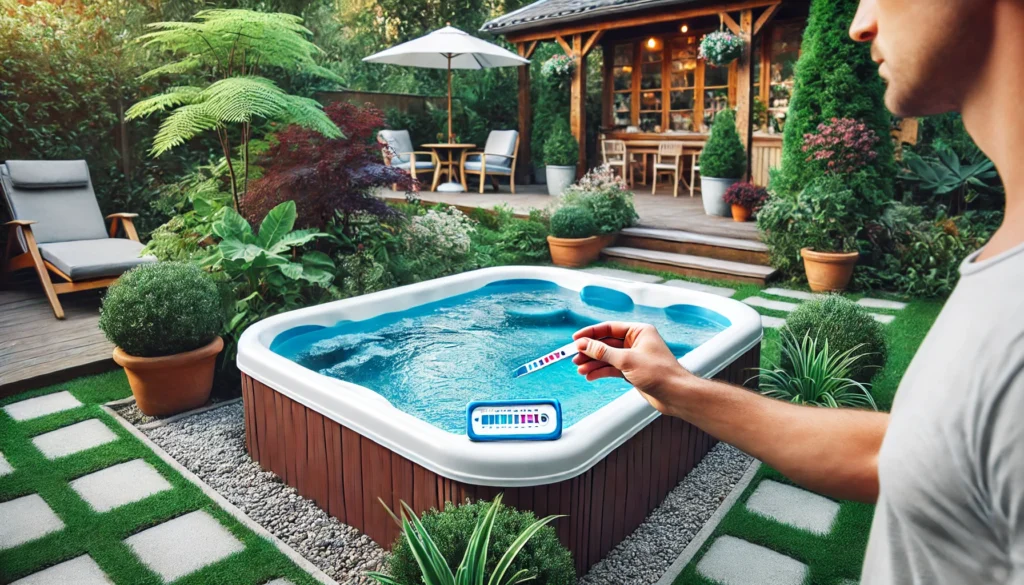
Alright, so you’ve got your alkalinity in check. Awesome!
But the work doesn’t stop there. Maintaining that sweet spot is key to keeping your hot tub happy (and avoiding the alkalinity rollercoaster I once found myself on).
Here are some tips I’ve picked up along the way:
- Test regularly. I’m talking at least once a week, folks.
Make it a part of your routine, like checking your email or watering your plants.
- Keep an eye on your pH. Alkalinity and pH are like two peas in a pod.
If one’s off, the other usually follows.
- Be mindful of what goes into your tub. Sweat, lotions, even laundry detergent residue on swimsuits can affect your water chemistry.
- Don’t forget about other factors. Rain, evaporation, and even heavy hot tub use can throw your alkalinity out of whack.
- Use a good quality alkalinity stabilizer. It’s like giving your hot tub a little insurance policy against fluctuations.
I once went on vacation and neglected my hot tub for two weeks. Let me tell you, coming back to a green, smelly mess was NOT the welcome home I was hoping for.
Learn from my mistake – a little regular maintenance goes a long way!
The Role of Alkalinity in Overall Water Balance
Here’s something I wish someone had told me when I first started out – alkalinity isn’t just about alkalinity. It’s part of a bigger picture called water balance.
There are three main components to water balance:
- pH
- Alkalinity
- Calcium hardness
These three musketeers work together to keep your water in tip-top shape. Alkalinity helps stabilize pH, while calcium hardness prevents your water from becoming too aggressive and eating away at your tub’s surfaces.
When you’re maintaining your alkalinity, you’re actually doing a lot more than you might realize. You’re helping to:
- Prevent scaling and staining
- Protect your equipment from corrosion
- Ensure your sanitizer (like chlorine or bromine) works effectively
- Keep the water comfortable for your skin and eyes
So pat yourself on the back – by managing your alkalinity, you’re really taking care of your whole hot tub ecosystem!
Troubleshooting Common Alkalinity Issues
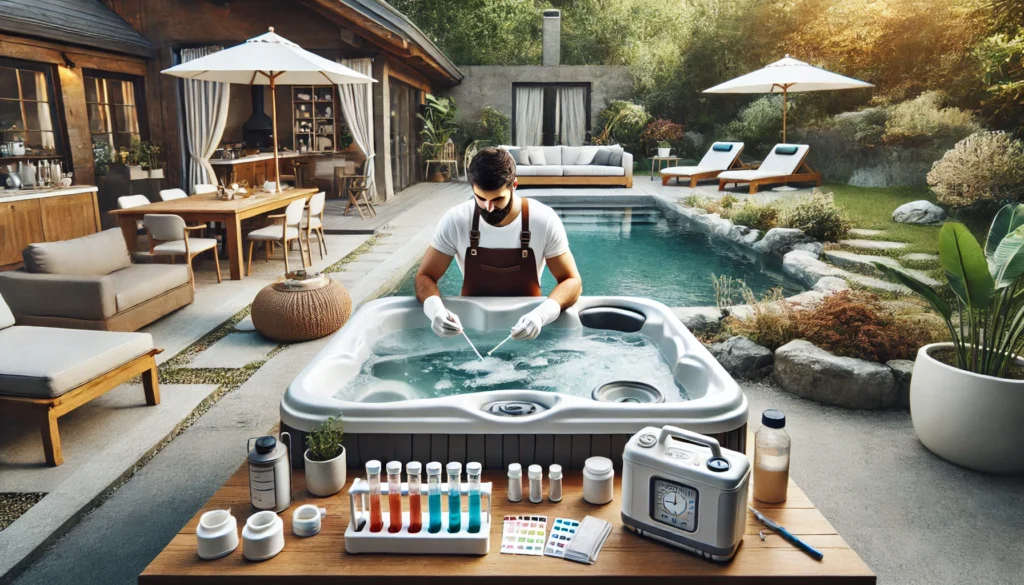
Even with the best care, sometimes things go wonky. Don’t worry, it happens to the best of us!
Here are some common issues I’ve faced and how I dealt with them:
- Alkalinity won’t stay stable: This was driving me nuts until I realized my pH was way off.
Balance your pH, and alkalinity often follows suit.
- Alkalinity keeps dropping: Check for leaks! I once had a slow leak that was throwing off my whole chemistry game.
- Alkalinity skyrockets after adding shock: Yep, been there. Some shock treatments can increase alkalinity.
Just be prepared to adjust afterwards.
- Can’t get alkalinity to budge: Make sure you’re using enough product. I once spent weeks under-dosing before I realized my hot tub was bigger than I thought!
Remember, every hot tub is unique. What works for me might need a little tweaking for you.
Don’t be afraid to experiment (safely, of course) and find what works best for your setup.
When to Seek Professional Help
Look, I’m all for the DIY approach. But sometimes, you gotta know when to call in the cavalry.
Here are some signs that it might be time to consult a pro:
- Your alkalinity levels are consistently unstable, despite your best efforts.
- You’re having trouble balancing alkalinity without throwing other parameters out of whack.
- Your hot tub is showing signs of damage, like scaling or corrosion.
- You’re experiencing skin irritation or other health issues after using your tub.
There’s no shame in asking for help. A professional can often spot issues you might have missed and can save you time, money, and frustration in the long run.
The Impact of Alkalinity on Hot Tub Enjoyment
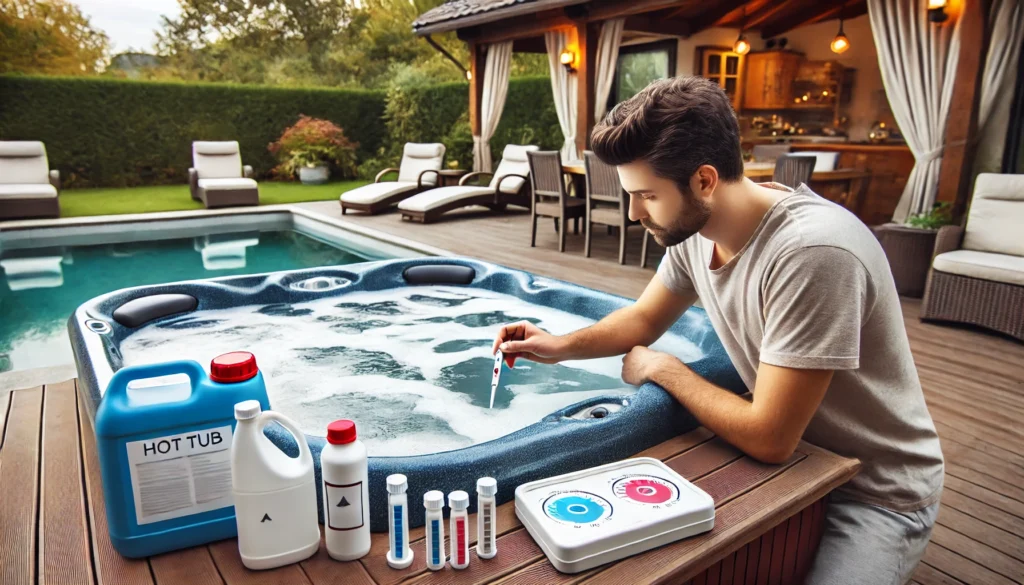
Let’s talk about why all this chemistry stuff matters. Sure, balancing alkalinity might not be the most exciting part of owning a hot tub, but trust me, it makes a world of difference in your soaking experience.
Proper alkalinity levels mean:
- Crystal clear water: No more cloudy, uninviting tub!
- Soft, silky-feeling water: Your skin will thank you.
- No more funky smells: Say goodbye to that “pool” odor.
- Longer-lasting equipment: Your pump and heater will keep running smoothly.
- Effective sanitization: Your chlorine or bromine will work better, keeping the water clean and safe.
I remember the first time I got my alkalinity just right. I sank into that tub, and it was like soaking in liquid silk.
No itchy skin, no weird smells, just pure relaxation. That’s what it’s all about, folks!
Conclusion
Alright, hot tub fans, we’ve been on quite the journey through the world of alkalinity! From understanding what it is to mastering the art of adjusting it, you’re now armed with the knowledge to keep your hot tub in tip-top shape.
Remember, maintaining proper alkalinity isn’t just about crystal-clear water – it’s about protecting your investment, ensuring your sanitizer works like a charm, and creating a safe, blissful soak for you and your guests.
Don’t sweat it if you don’t nail it right away. It took me ages of trial and error before I got the hang of it.
The secret sauce? Consistency in testing and adjustments, and not being shy about asking for help when you need it.
Hot tub maintenance might seem like a chore at first, but trust me, it becomes second nature faster than you can say “bubble bath.” And the payoff?
Those worry-free, relaxing soaks under the stars. There’s nothing quite like sinking into perfectly balanced water after a long day.
So, what’s your next move? Grab those test strips, roll up your sleeves, and dive into balancing your hot tub’s alkalinity.
Your future self will thank you when you’re enjoying that perfect soak. And hey, if you’ve got any cool tips or tricks you’ve discovered along the way, drop them in the comments below.
After all, we’re all in this hot water together!
Stay bubbly, and happy soaking!


